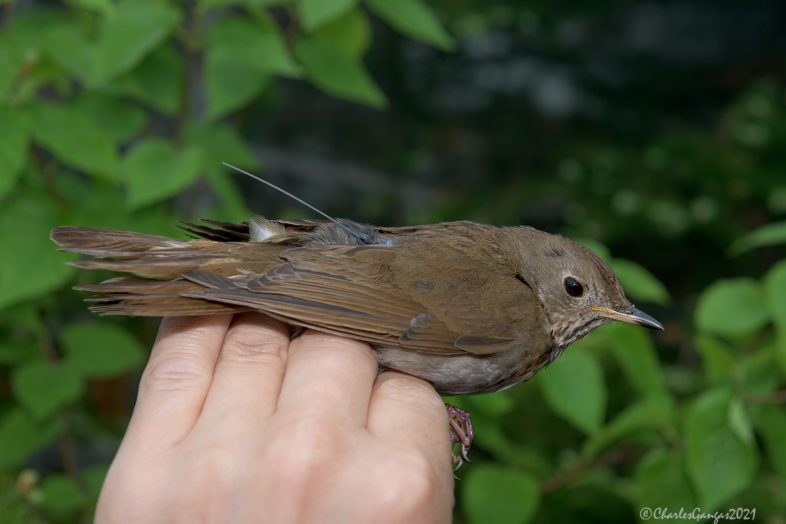
Tying the longevity record of 11 years for Bicknell’s Thrush, this male—banded on Mt. Mansfield as a yearling in June of 2011—is ready for release with its 1.1-gram archival GPS tag programmed to collect vital information on movements and habitat use over the next 11+ months. © Charles Gangas
While 30 years of studying Mt. Mansfield’s ridgeline breeding birds may constitute impressive research longevity, it pales next to the endurance and perseverance of Bicknell’s Thrush (BITH) #2341-24085. On Tuesday 8 June, the VCE field crew mist-netted a male BITH with a band that was clearly old, but that didn’t seem unusually so—we recapture many individuals from one year to the next. So, we went ahead and processed the bird, adorning him with a stylish lightweight GPS tag (one of 7 we applied during our overnight banding session), recorded his weight at a robust 29.7 grams, and sent him on his way. A day later, we checked our data base and were astounded to find that 2341-24085 had tied our all-time record for longevity in BITH, set on Stratton Mountain back in 2008!
We first banded 2341-24085 on 3 June 2011 as a yearling male, from a mist net on the beginning of the Amherst Trail. We’ve since recaptured him 14 times, at least once in every subsequent year through 2018, including during our mid-September wrap-up banding sessions in 2014 and 2016. However, he eluded us in both 2019 and 2020. After that well-deserved break from VCE’s clutches, 2341-24085 reappeared on 8 June as a verifiable 11 year-old, tying him with a male we banded as a yearling on Stratton in 1997 and recaptured no fewer than 27 times—missing him in only one year—before our final encounter in July of 2008.
This is nothing short of extraordinary, especially for a long-distance migrant breeding in a high-elevation environment that challenges any life form! We’ll soon do some sleuthing, but I strongly suspect that VCE’s banding records will demonstrate BITH surviving longer than most similar-sized passerines with wintering grounds in the Caribbean or Latin America. In addition to 2341-24085 and our Stratton 11 year-old, we’ve documented two other 10 year-old male BITH on Mansfield. This is one tough warrior of a species. A quick look at longevity data for other long-distance North American migrants may not put BITH in its own class—a Great Crested Flycatcher lived to 13 years and 11 months, a Warbling Vireo to 13 years and 1 month, but, these two species inhabit “cushy” low elevations at both ends of their range, Consider not only the rugged mountainous terrain where BITH live in summer and winter, but the fact that 2341-24085 has negotiated 11 annual round-trip flights to the Greater Antilles, conservatively 1,800 miles each way, so ~40,000 miles in all. You just have to admire the species’ fortitude!
Not only did 2341-24085 astonish us with his longevity, but he was among the first 7 BITH to receive a miniaturized archival GPS tag, as VCE launches an exciting new study that will add a critical piece to the full annual cycle puzzle of BITH. In short, these archival tags (meaning we have to recover them and download the data a year from now) will collect spatially precise information on BITH locations, movements and habitat use on their Caribbean wintering grounds during the upcoming winter. We have long suspected that BITH undertake late winter movements off their non-breeding territories, but we have no idea when they leave, where they go and what habitat(s) they use. Termed “intratropical migrations” (ITMs), these seasonal movements, which have been documented in congeneric Swainson’s Thrush and Veery, may play a key role in the conservation equation for BITH. We plan to attach 40 of these tiny 1.1-gram backpacks to adult BITH over the next 8 weeks, ands we’re hopeful of recovering at least 20 next June and July.
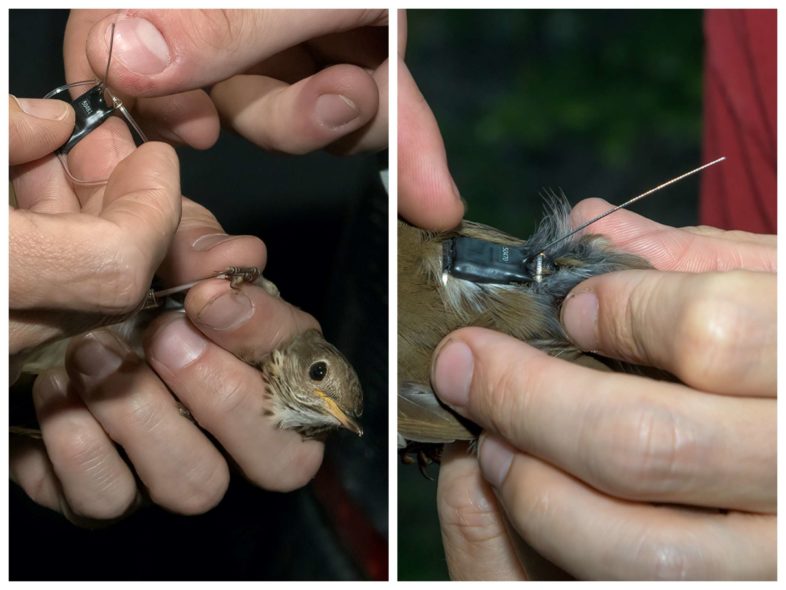
An adult Bicknell’s Thrush prior to (left) and just after (right) receiving a miniaturized, lightweight GPS tag programmed to collect critical data on its movements and habitat use over the next 11+ months. Mt. Mansfield, 8 June 2021. © Charles Gangas
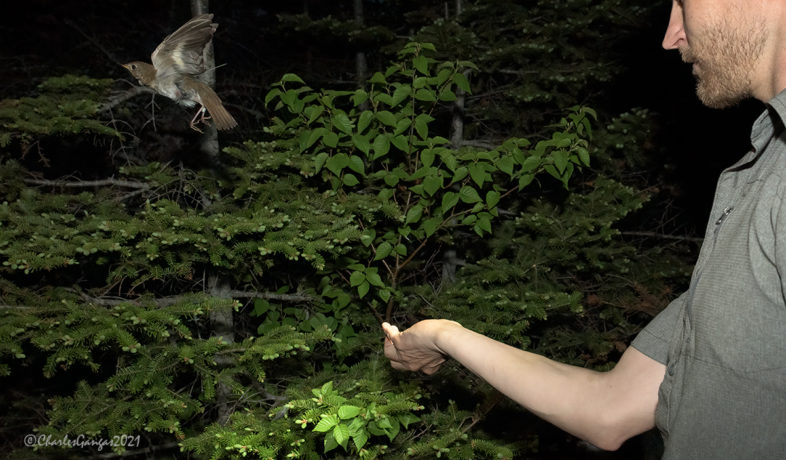
Chris Hansen releases one of the first Bicknell’s Thrush to carry an archival GPS tag at dusk on 7 June 2021, Mt. Mansfield. © Charles Gangas
BITH longevity and GPS tagging aside, we ran our 26 ridgeline mist nets as usual on Monday evening and Tuesday morning, capturing fewer birds than a week ago and many fewer transients from lower-elevation habitats, a White-breasted Nuthatch being the sole exception. Having wondered whether last week’s flush of unbanded Blackpoll Warblers—including 12 females—reflected some late northbound migrants, we were interested to recapture 5 of those females (and 5 males) this week. Our total of 38 captures included:
Yellow-bellied Flycatcher — 1 new, unknown sex
White-breasted Nuthatch — 1 female w/regressing brood patch
Winter Wren — 1 new, unknown sex
Bicknell’s Thrush — 8 (6 males, 2 females; 2 new, 4 returns [1 from 2011 and 2019, 2 from 2020], 2 within-season recaptures)
American Robin — 1 new male
Dark-eyed Junco (Slate-colored) — 6 (4 new, 1 return male from 2020, 1 within-season recap female w/full incubation patch)
White-throated Sparrow — 2 new males
Blackpoll Warbler — 11 (1 new female, 10 within-season recaptures [5 males, 5 females])
Yellow-rumped Warbler (Myrtle) — 9 (6 new, 2 return males from 2020, 1 within-season recapture)
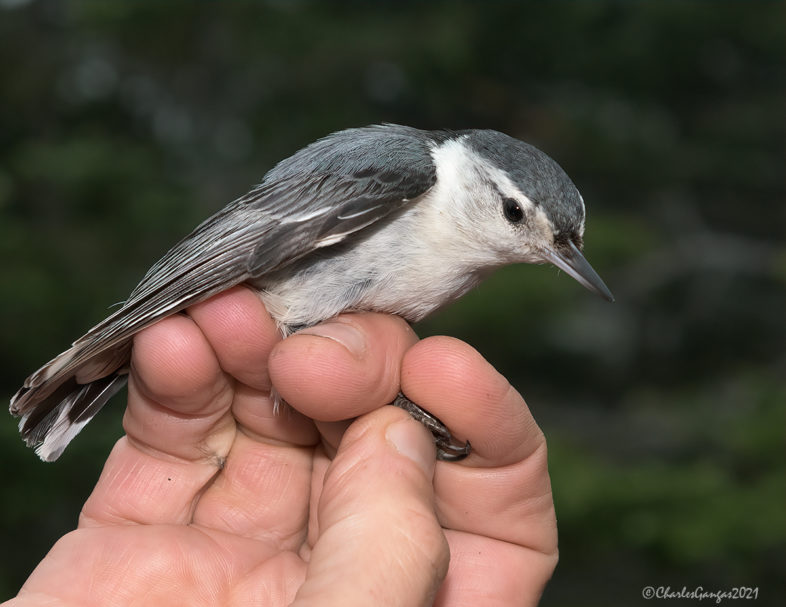
An out-of-habitat female White-breasted Nuthatch banded on Mt. Mansfield, 8 June 2021. © Charles Gangas
During the weeks ahead, we hope to encounter 2341-24085 again, though we’re even more eager to welcome him back in June of 2022 and unlock the geographic secrets from his GPS tag. We face a challenge to capture 33 additional adults, but with our long-term array of 25+ nets and some targeted netting just outside our main study plot, we’re confident. Longtime VCE colleague Yves Aubry of the Canadian Wildlife Service will tag an additional 15 adults in southern Quebec, adding an invaluable component to this study. VCE’s dedicated field crew will get the job done!
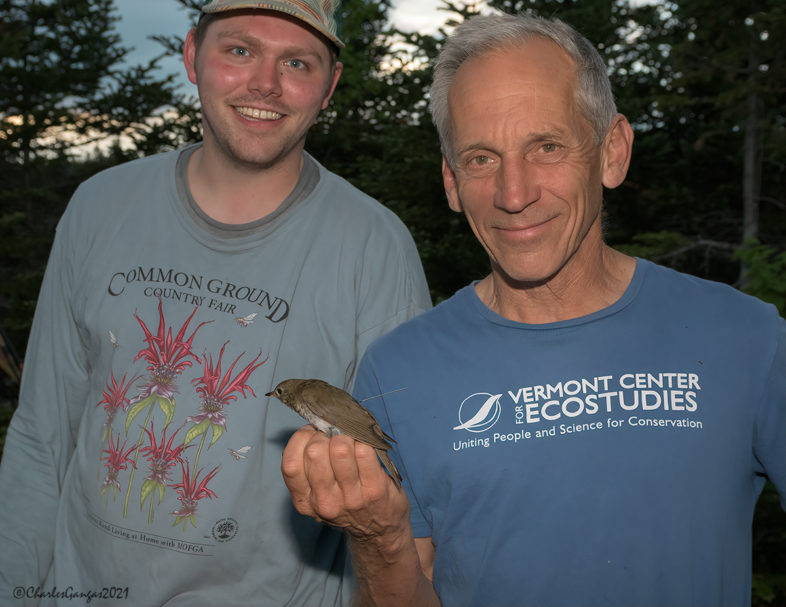

Chris – great shot of two grizzled veterans…that’s how I feel when I hold a 9-yr-old Ruby-throated Hummingbird. I’ve held two so far in the Adirondacks, one at my camp at Jenny Lake near Corinth, the other at Schroon Lake.
Intriguing stuff you are doing.
Great work to all but the real surprise is to see a “youthful biologist” like Chris along with the two “grizzled veterans” : BITH and Kevin.
I taught him everything I know!
I always enjoy reading your Mt Mansfield reports Chris but this one put an extra big smile on my face. Come on BITH 2341-24085….give us a show in 2022!
What a thrill! The surprise and excitement of discovering this ancient
Wow that is one tough BITH! To think of all the hazards of migration that this bird has avoided is truly remarkable.
Thanks to Chris and the team for providing exciting news.
Sue Wetmore
Sent from my iPhone
Chris, Wow! Using miniature GPS to unravel the intraterritoral migration story is so exciting and one of the reasons I enjoy supporting VCE!